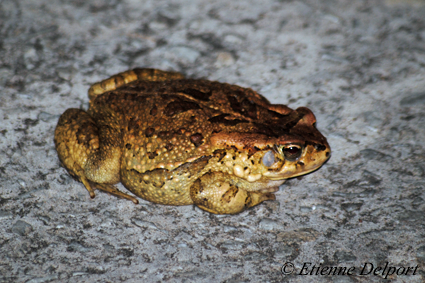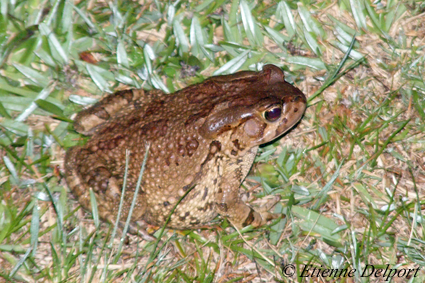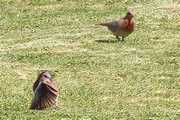Identification. The Raucous Toad (Amietophrynus rangeri)1 grows to about 10 to 11.5 cm in length. This large toad is stout with a blunt head and squared appearance. The skin is rough and dry with wart-like glandular elevations on the upper side and includes a pair of large and distinctive parotid glands on the neck. The eye has a horizontally elliptical pupil. The hind legs are longer than the body. There are no hard ridges on the heel of the hind foot nor discs on the toes, but the toes are slightly webbed with a narrow margin of webbing along the edges. The upper body surface is brown with irregular pairs of darker brown patches on the back. These are sometimes fused together across the midline and usually there is a dark bar between the eyes. A pale vertebral line may be present from the shoulders downwards. The underside is a dirty white with a granular texture.

Habitat. The Raucous Toad occurs in a variety of habitats including farmlands and gardens. It breeds in dams, ponds and pools along slow-forming streams, tending to favour permanent water but it spends most of its time away from water. Like many toads it will visit houses and other places where insect prey are attracted to lights, mainly outside the breeding season. It then establishes itself in moist, sheltered spots such as behind flowerpots and becomes tame if not molested.
Diet. Raucous Toads will eat practically any small animal, including small vertebrates, but mainly insects up to the size of crickets.
Call. The Raucous Toad’s loud advertisement call comprises short, rasping duck-like quacks repeated incessantly at about two per second. It quacks almost the entire breeding season, generally in groups of males near the water’s edge.
Breeding. Raucous Toads breed in spring and summer. Males call singly or in groups, generally from an open position along the edge of a water body or from a rock protruding above the water level. Their calls can be heard both day and night, but mainly at night. The eggs are laid in double jelly-like strings each about 5 mm thick, and become wrapped around vegetation and other objects in the water. The eggs develop into free-swimming benthic tadpoles which are dark brown to black in colour and reach a length of 25 mm. Metamorphosis is reported as taking at least five weeks after which the young toads leave the water.

South African Distribution. The Raucous Toad occurs throughout most of South Africa, especially the eastern and southern parts, but appears to avoid the Tankwa Karoo and sandy coastal areas.
Port Elizabeth Area. There’s an abundance of Raucous Toads in Port Elizabeth. They may be spotted in most gardens after sunset.
Conservation Status – LC (Least Concern)2 Listed as Least Concern in view of its wide distribution, tolerance of a broad range of habitats, presumed large population, and because it is unlikely to be declining fast enough to qualify for listing in a more threatened category.
- Raucous Toad entry on Wikipedia ▲
- IUCN Redlist – Raucous Toad Fact Sheet ▲


